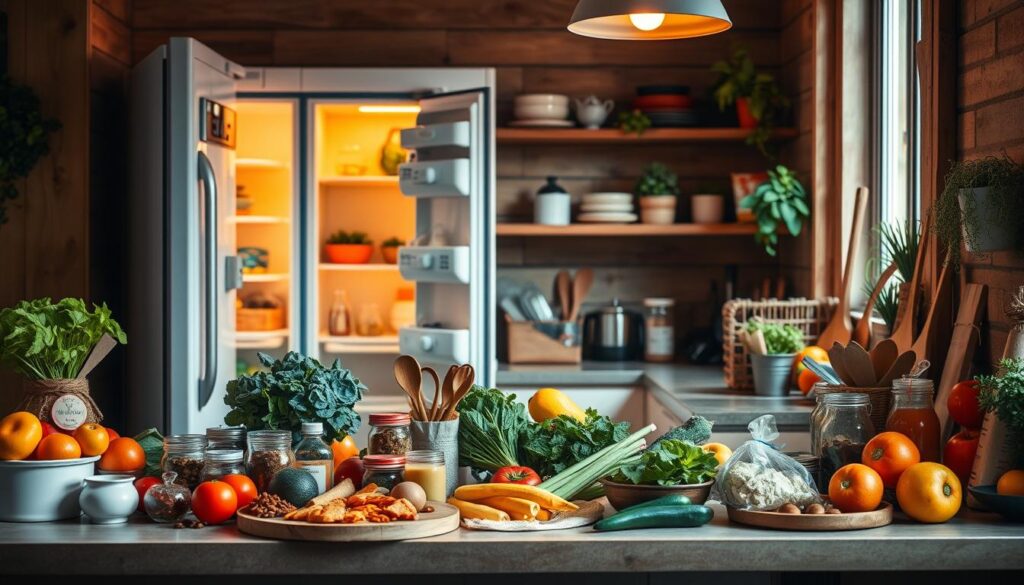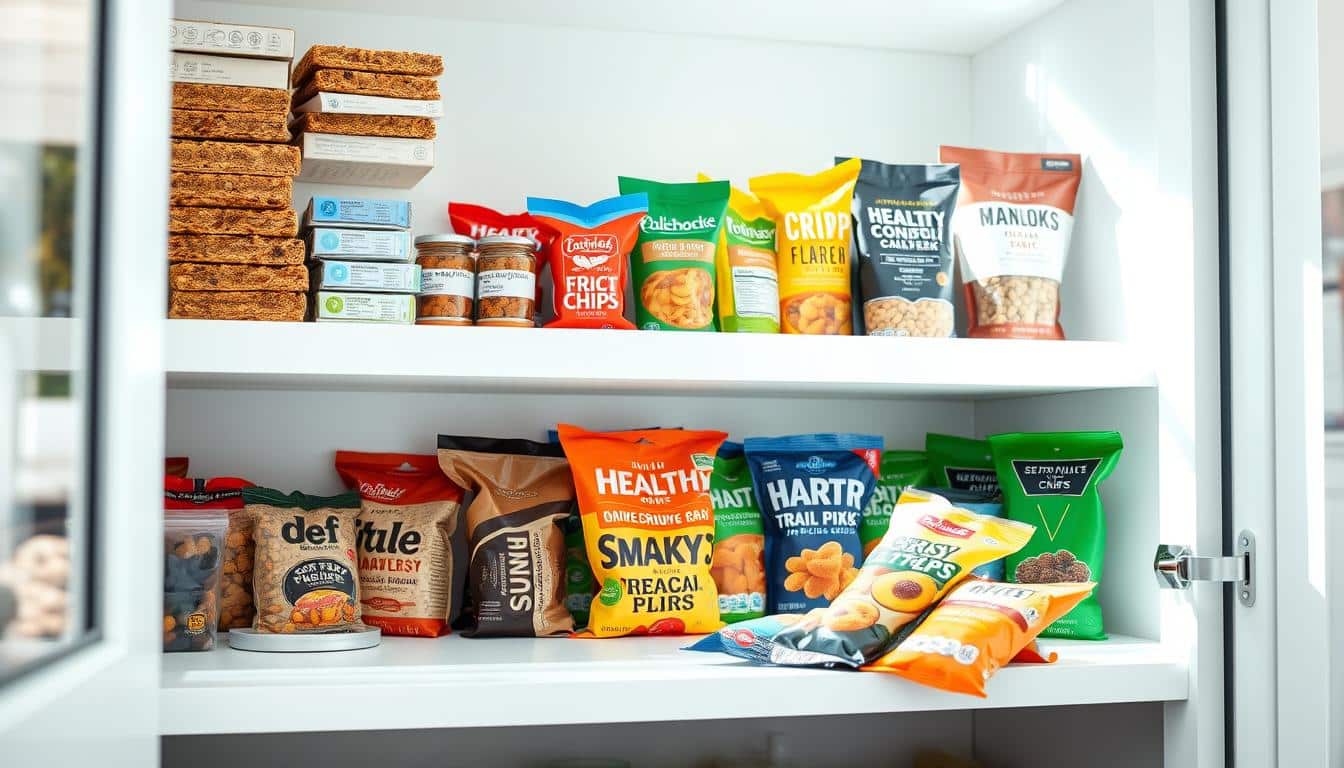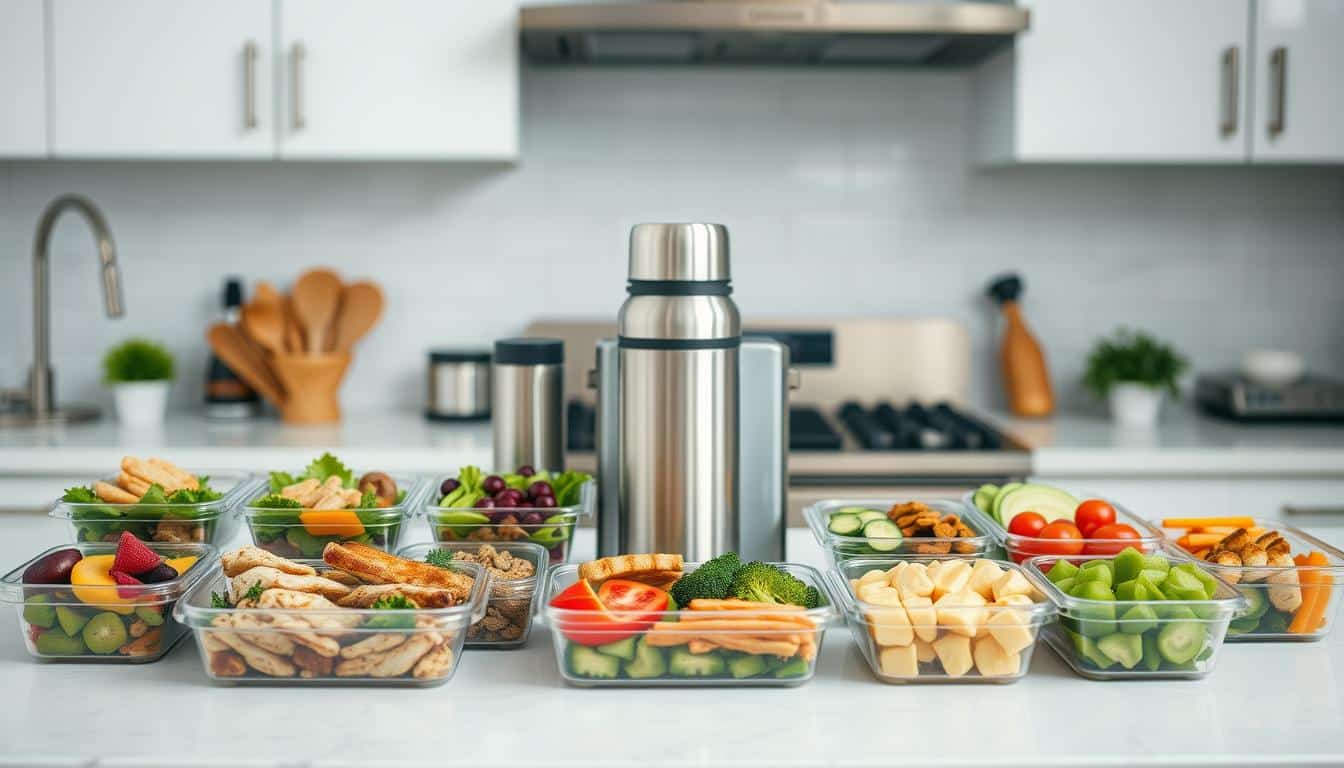Effective meal planning is essential for a healthy life, even when busy. By choosing quick, portable meals, you’ll eat better easily. It simplifies picking lunches and improves eating habits. This piece looks at meal planning’s perks, goals, and tips for busy lives, making meals both easy and tasty.
Why Meal Planning is Essential for Work Success
Meal planning is key to success at work. It helps manage time well and reduces stress. With meals planned, you can focus on work without worrying about food.
Save Time and Reduce Daily Stress
Pre-planned meals cut down on chaos. They let professionals concentrate on work, not food. This saves time and lowers stress.
Stay Within Your Budget
Meal planning keeps your budget in check. It avoids sudden, costly grocery buys and expensive fast food. This way, you can eat well without spending too much.
Promote Healthier Eating Choices
Planning your meals leads to healthier eating. You pick good ingredients over bad food choices. This boosts your energy and focus at work.
Identifying Your Meal Planning Goals
Having clear goals for meal planning is key to better budgeting and improving your health. People often aim to save money by planning their meals in advance. This strategy makes it easier to dodge unplanned spending, helping you buy only what you really need for the week. It also reduces the chance of opting for last-minute takeout, which can get pricey.
Saving Money
Saving money is a big reason why people plan their meals. By setting up a meal plan for the week, you can make a shopping list that only includes what you need. This approach cuts down on buying things you don’t need, which is great for your wallet. It also leads to healthier eating since you’re making smart choices on purpose.
Reducing Food Waste
Dealing with food waste is also key to good meal planning. When you plan your meals carefully, you’re less likely to buy more than you can use. It helps make sure nothing goes bad before you get to it. Plus, if you have leftovers, you can turn them into something new, using up all your ingredients.
Evaluate Your Weekly Schedule
Reviewing your meals each week is key to planning well. Knowing what your week looks like helps you arrange your meals smartly, especially on busy days. You can figure out which days need quick meals. This makes it easier to choose simpler recipes for hectic times and save the fancy ones for when you have more time.
Identify Busy Days for Quick Meals
Checking your calendar helps find the days when you’ll need fast meals. On these busy days, opt for recipes that are quick. You should choose meals that are ready in under 30 minutes. Here are some examples of what you might pick:
- Stir-fried vegetables with pre-cooked chicken
- Tacos with canned beans and fresh toppings
- One-pot pasta dishes
Plan for Leftovers and Frugal Lunches
Using leftovers smartly saves money. When making your meal plan, think about meals that can be eaten again the next day. For instance, a roasted chicken can turn into different meals for lunch the next day. This saves you both time and money. It lets you enjoy a variety of meals all week without spending too much.
Create a Recipe Rotation
Setting up a recipe rotation makes meal planning easier. It lets families have different meals without the stress of choosing what to cook daily. With a clear meal plan, eating becomes more structured and fun.
Standardize Meals for Specific Days
Planning meals for certain days can make your week smoother. For instance:
- Meatless Mondays
- Taco Tuesdays
- Fish Fridays
This method makes grocery shopping faster because you know what ingredients you need ahead of time.
Incorporate Family Favorites
Adding meals everyone loves to your recipe rotation creates a sense of comfort. Ask your family for their favorite dishes to include. This makes everyone more excited about meal times.
With favorites in your meal plan, you not only get to eat well but also make meal times special for everyone.
Essential Ingredients for Elevator-Friendly Meals
For great meal planning, start with a well-stocked pantry. Keep basics like grains, legumes, and sauces. This makes quick meals easy all week. Add seasonal produce to boost your meals. This way, you get tasty food without overspending. Choosing these in-season items adds flavor and saves money. This ensures you enjoy every meal.
Stock Your Pantry with Staples
It’s key to have the right pantry staples for fast, tasty meals. Make sure you have:
- Rice and pasta
- Canned beans and lentils
- Cooking oils and vinegars
- Spices and herbs
- Canned tomatoes
Combine these staples with fresh stuff to make lots of different dishes. This way, you visit the grocery store less. It also gives you more ways to cook.
Utilize Seasonal and Affordable Produce
Using seasonal produce boosts flavors and supports local farms. Plus, it’s cheaper. Seasonal veggies and fruits are fresher and cost less. Here’s why seasonal produce is great:
- Nicer taste from being fully ripe
- Costs less at local markets
- Offers more variety all year
Focusing on seasonal, affordable ingredients makes meal planning better. It’s good for your wallet and the planet. With these essentials, your meals will be tasty and easy to make.
Meal Prepping Tips for Busy Schedules
Meal prepping is a great way to manage busy lives. It involves making lots of food at once. This way, you always have healthy meals ready. Using simple recipes makes cooking easier and more enjoyable.
Batch Cooking for Time Efficiency
Batch cooking is key for meal prepping. It means making many meals at the same time. This saves time for those with busy schedules. Here are some tips to make batch cooking work better:
- Choose versatile ingredients that can be used across different meals.
- Cook in large quantities and divide meals into individual portions.
- Utilize freezer-friendly containers to store portions for later use.
Use Easy Recipes for Meal Prep Days
When meal prepping, choose simple recipes. Look for ones that are quick and need few ingredients. This makes it easier to keep up with meal prepping. Here are some fast recipe ideas to try:
- Stir-fry vegetables and proteins that can be quickly reheated.
- Soups and stews that develop flavor when cooked in larger batches.
- Salads that can be assembled ahead of time and stored separately from dressings.
Elevator-Friendly Meal Planning Tips for Work
Meal planning for work can really help keep your energy and productivity up. Choosing meals and snacks that are easy to carry and eat is key. Here are some easy and healthy meal ideas for you.
Healthy, Portable Meal Ideas
It’s important that your meals are easy to take with you and good for you. You could try:
- Jar salads that layer greens, vegetables, and protein for easy transport
- Wrap sandwiches filled with lean meats, veggies, and spreads
- Grain bowls that combine quinoa or brown rice with roasted vegetables and beans
These options are tasty and perfect for taking to work. Having them ready to go makes your lunch break easy. This means you can stay focused on your work, not on what you’re going to eat.
Include Snacks to Stay Energized
It’s also smart to have snacks during the day. They help keep you feeling full and focused. Good choices include:
- Mixed nuts that provide healthy fats and protein
- Fresh fruits for a quick, sweet source of energy
- Vegetable sticks paired with hummus for a nutritious crunch
Snacks like these stop you from feeling too hungry and help you keep working hard. They make sure you’re always ready to tackle your next task.
Utilizing Technology for Meal Planning
In today’s world, technology makes meal planning much easier. There are many apps to help organize recipes and improve shopping. They let you make digital grocery lists, which are key for buying what you need.
Apps and Tools for Efficient Planning
Lots of meal planning apps are available for different tastes and needs. Whether you like simple apps or ones with many features, they all help you find new recipes, adjust meal sizes, and consider dietary needs. These tools make meal planning easy and fun.
Digital Grocery Lists to Avoid Overbuying
Digital grocery lists help stop you from buying too much. They make it easy to track what ingredients you really need, no more guessing. This way, you buy only what’s necessary, helping you save money and reduce waste.
Flexibility in Your Meal Plan
Being flexible while planning meals is key to eating well. Life can throw curveballs, like a sudden change in routine or not finding the ingredients you need. By having a flexible approach, you can still eat healthily when things don’t go as planned.
Prepared Backup Meal Options
It’s great to have backup meals ready for when you’re short on time. Here are some quick meal ideas:
- Frozen vegetable stir-fry with pre-cooked rice
- Canned soups and whole-grain crackers
- Pre-packaged salad kits ready to mix
- Grain bowls with quinoa or couscous topped with beans and veggies
These meals are fast and don’t skimp on nutrition, helping you keep up with healthy eating.
Adapting Meals Based on Fresh Ingredients
Use what you have to cut down on waste and keep things interesting. When you have fresh ingredients about to spoil, change your meal plan to use them. For instance:
- If you have extra spinach, add it to smoothies, stir-fries, or salads.
- Incorporate leftover meats into casseroles or grain salads.
- Use seasonal vegetables as the base for soups or stews.

Reflection and Adjustment of Your Meal Plan
Regularly assessing your meal plan helps refine your approach and boosts satisfaction. Reflect on the strong and weak points. Make adjustments to better match your personal tastes and daily life. This keeps your meal planning game strong and lasting.
Assess What Worked and What Didn’t
Getting thoughts from family or coworkers can greatly improve meal planning. Here’s how to make your review more effective:
- Document meals that were hits and misses.
- Solicit input from those who share in the meals.
- Adjust portion sizes and flavors based on preferences.
- Note any logistical challenges encountered during the week.
Taking time for a detailed meal plan review and using feedback wisely leads to happier meal times all week.
Conclusion
Planning your meals can help you eat healthily, especially when you’re busy. By using the tips we’ve shared, you can make meals that are good for you. These meals keep you full and fit your schedule.
Packing lunch for work can both save you time and money. It makes your day go smoother. With meal prep, you always have good food ready. This helps you avoid choosing junk food.
Getting good at meal planning means you can handle busy days better. It helps you keep up with healthy eating all the time. With some effort and the ability to adjust, you can find the best meal plan for yourself.



